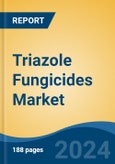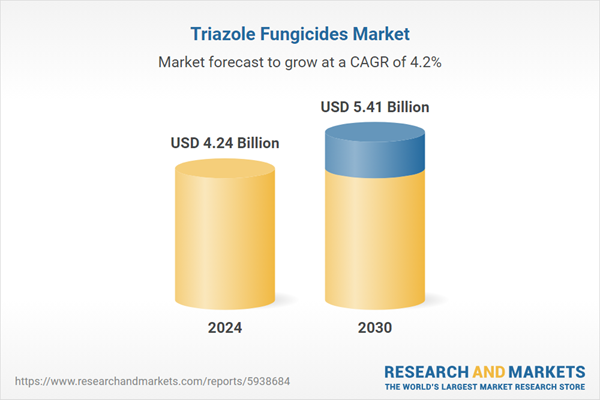Free Webex Call
The Triazole Fungicides Market was valued at USD 4.24 Billion in 2024, and is expected to reach USD 5.41 Billion by 2030, rising at a CAGR of 4.15%. Triazole fungicides play a crucial role in safeguarding crops against fungal infections, offering efficient protection against fungal spores and a wide range of other fungal diseases. Moreover, these fungicides contribute significantly to improving crop productivity, ensuring a bountiful harvest. Speak directly to the analyst to clarify any post sales queries you may have.
10% Free customizationThis report comes with 10% free customization, enabling you to add data that meets your specific business needs.
The growth of the triazole fungicides market is driven by the increasing prevalence of fungal diseases in plants and crops. This emerging trend necessitates the adoption of effective fungicides to combat the challenges faced by farmers. Additionally, the expansion of the agrochemicals industry and the growing focus on practices that enhance overall crop productivity further fuel the demand for triazole fungicides.
Furthermore, the market is expected to witness lucrative growth opportunities due to increased investments in research and development for new product launches. The rising disposable income of individuals also contributes to the market's growth potential. Moreover, the rising demand for fresh fruits and vegetables, coupled with the effects of globalization and the growing awareness among farmers, further propels the growth of the triazole fungicides market.
However, stringent governmental regulations pertaining to product approvals and the use of synthetic chemicals present significant challenges to the market's growth. Moreover, concerns regarding the harmful effects of such chemicals on crops and human health act as obstacles, hindering the growth rate of the triazole fungicides market. The increasing focus on environmental sustainability further poses a threat to the market's growth trajectory.
Despite these challenges, the triazole fungicides market remains resilient, driven by the need for effective crop protection solutions and the continuous pursuit of sustainable agriculture practices.
Key Market Drivers
Growing Demand for Food Security
This scenario has put a significant spotlight on the urgent need for effective crop protection measures, such as the use of triazole fungicides. These fungicides, known for their exceptional efficacy in controlling a wide range of crop diseases, have become indispensable for farmers in safeguarding their crops from devastating diseases that can result in substantial yield losses. By inhibiting the growth of fungi, triazole fungicides play a crucial role in preventing diseases that pose a significant threat to crop quality and quantity. With the ever-increasing demand for food security, the adoption of these fungicides has witnessed a remarkable surge. In fact, farmers worldwide are increasingly recognizing the numerous benefits of incorporating triazole fungicides into their crop protection strategies, leading to improved yield and better overall crop health.Furthermore, the easy availability and accessibility of crop protection products like triazole fungicides have further contributed to their widespread adoption. As farmers become more aware of the advantages and positive impact of these fungicides on their crops, the demand for triazole fungicides is expected to continue its upward trajectory.
According to a June 2021 report by the Food and Agriculture Organization, a specialized agency of the United Nations based in Italy, about 40% of global crop production is lost each year due to pest damage. Moreover, plant diseases alone result in an annual global economic loss of approximately $220 billion, with invasive insects accounting for around $70 billion of that total. As a result, the urgent need for disease management and crop protection is a major driver of growth in the triazole fungicide market.
In conclusion, the global triazole fungicides market is being driven by the escalating demand for food security. As the world seeks secure and sustainable food sources, the crucial role of triazole fungicides in ensuring crop protection becomes increasingly paramount. This, in turn, is anticipated to fuel the growth of the triazole fungicides market in the coming years, serving as a vital pillar for global food production and security.
Key Market Challenges
Surge in Regulatory Concerns
Regulatory agencies worldwide are becoming increasingly stringent in their regulations concerning the use of chemical fungicides, particularly triazoles. This is in response to mounting environmental and health concerns. The widespread production and application of triazoles have sparked heightened scrutiny regarding their potential toxicity. Furthermore, the introduction of azoles has coincided with a noticeable rise in azole-resistant human fungal pathogens. This development poses a significant threat to the effectiveness of these fungicides and raises serious concerns about their continued use. These regulatory concerns have created a challenging environment for the triazole fungicides market.As a result, companies now face stricter approval processes, heightened research and development costs, and potential market constraints. In addition to the regulatory challenges, global brands involved in triazole fungicides also grapple with the task of preserving their market share amidst growing public awareness and apprehension regarding the potential risks associated with these products. The reputation of these brands is at stake as they navigate this complex landscape.
Key Market Trends
Rising Popularity of Broad-Spectrum Fungicides
Broad-spectrum fungicides, such as strobilurin and demethylase inhibitors (DMIs), have gained prominence in the agricultural industry due to their versatility and efficacy. These fungicides have the ability to control multiple types of fungi, making them suitable for a wide range of crops. Their effectiveness in disease control has been well-established, contributing significantly to farming practices for over 150 years. In addition to their disease-fighting capabilities, broad-spectrum fungicides have played a vital role in minimizing crop loss and increasing plant yield. Their undeniable impact has positioned them as essential tools in modern agriculture.Farmers rely on these fungicides to combat prevalent diseases such as powdery mildew, smut, and corn spot disease, resulting in a significant demand for these products in the triazole fungicides market. While the use of broad-spectrum fungicides continues to rise, there is also a noteworthy trend towards the increasing popularity of bio-based fungicides. These bio-based alternatives are seen as more environmentally friendly and sustainable, offering a promising opportunity for the triazole fungicides market. With their unique characteristics and potential benefits, bio-based fungicides present an alternative solution that aligns with the growing demand for eco-friendly agricultural practices.
Overall, the combination of broad-spectrum fungicides and the emergence of bio-based alternatives signifies a dynamic landscape in the triazole fungicides market. As the industry evolves, the demand for effective disease control solutions and sustainable farming practices will continue to shape the future of fungicides in modern agriculture.
Key Market Players
- BASF SE
- Marrone Bio Innovations, Inc.
- Adama Agricultural Solutions Ltd
- Nufarm Agriculture Inc
- Nippon Soda Co., Ltd.
- The Dow Chemical Company
- SEIPASA, S.A.
- Syngenta Crop Protection AG
- FMC Corporation
- LANXESS AG
Report Scope:
In this report, the Global Triazole Fungicides Market has been segmented into the following categories, in addition to the industry trends which have also been detailed below:Triazole Fungicides Market, By Type:
- Propiconazole
- Tebuconazole
- Difenoconazole
- Others
Triazole Fungicides Market, By Application:
- Field Crops
- Fruit Trees
- Vegetables
- Others
Triazole Fungicides Market, By Region:
- North America
- United States
- Canada
- Mexico
- Europe
- France
- United Kingdom
- Italy
- Germany
- Spain
- Asia-Pacific
- China
- India
- Japan
- Australia
- South Korea
- South America
- Brazil
- Argentina
- Colombia
- Middle East & Africa
- South Africa
- Saudi Arabia
- UAE
Competitive Landscape
Company Profiles: Detailed analysis of the major companies present in the Global Triazole Fungicides Market.Available Customizations:
With the given market data, the publisher offers customizations according to a company's specific needs. The following customization options are available for the report.Company Information
- Detailed analysis and profiling of additional market players (up to five).
This product will be delivered within 1-3 business days.
Table of Contents
1. Product Overview
2. Research Methodology
3. Executive Summary
5. Global Triazole Fungicides Market Outlook
6. Asia Pacific Triazole Fungicides Market Outlook
7. Europe Triazole Fungicides Market Outlook
8. North America Triazole Fungicides Market Outlook
9. South America Triazole Fungicides Market Outlook
10. Middle East and Africa Triazole Fungicides Market Outlook
11. Market Dynamics
12. Market Trends & Developments
14. Porter’s Five Forces Analysis
16. Competitive Landscape
Companies Mentioned
- BASF SE
- Marrone Bio Innovations, Inc.
- Adama Agricultural Solutions Ltd
- Nufarm Agriculture Inc
- Nippon Soda Co., Ltd.
- The Dow Chemical Company
- SEIPASA, S.A.
- Syngenta Crop Protection AG
- FMC Corporation
- LANXESS AG
Table Information
| Report Attribute | Details |
|---|---|
| No. of Pages | 185 |
| Published | February 2025 |
| Forecast Period | 2024 - 2030 |
| Estimated Market Value ( USD | $ 4.24 Billion |
| Forecasted Market Value ( USD | $ 5.41 Billion |
| Compound Annual Growth Rate | 4.1% |
| Regions Covered | Global |
| No. of Companies Mentioned | 10 |









